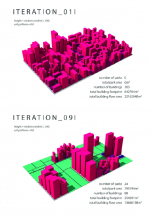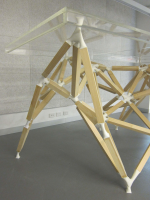Explaining the Rapid Learning Methodology

Explaining the Rapid Learning Methodology
Is your university struggling to keep pace with the changing tide of Architecture and Engineering software? New technologies place constant demands on educators. The Rapid Learning Methodology could be the answer.
Over the past 30 years, the architecture and engineering sectors have changed. In the past, you relied on hand-drawn plans and prototypes. Today, you have all manner of technologies at your fingertips. Digital design software has evolved enormously during the last three decades. It’s now capable of creating realistic 3D representations of any object.
But that’s not the only new technology that you must concern yourself with. Virtual and augmented reality will spark changes in the way you help clients visualise your designs. 3D printing allows you to create even better prototypes. Even artificial intelligence will play a huge role in the future of the industry.
And that’s before you start thinking about new methods. Building Information Modelling is becoming more popular. That’s something else that you have to adapt to.
All of these changes present plenty of challenges to experienced professionals. But what about those who are currently training to enter the industry?
Failure to cover the important information about such advancements will leave them unprepared. This leaves lecturers and tutors with a monumental task. You not only have to teach lessons related to these new technologies. You also have to learn about them yourself.
How do you do that? This article looks at the major pain points that you face and examines a new learning methodology.
The Issues That Universities Face
So, what are the issues that universities face in helping students understand the technologies they’ll work with?
Here are five major pain points to consider.
Pain Point #1 – Differing Digital Design Software Skills

Just think about the sheer number of digital design software packages available today. There are dozens of them. Each requires a different set of skills to use correctly. Moreover, some focus on specific technologies and methodologies. For example, Revit aligns with the Building Information Modelling methodology. Plus, we’re seeing lots of new virtual reality-related software packages appearing.
It’s impossible for a single tutor to master all of these digital design software packages. Even an entire team can’t cover everything. Students studying a software package may end up disappointed when they ask technical questions. If you can’t provide the answer, the student may lose confidence in you as a teacher.
Pain Point #2 – It’s Hard to Find Good Tutors

This is an issue that you’ll face with almost every subject that your university teaches. Good tutors inspire confidence while delivering the desired learning outcomes. That sounds so simple. But it’s actually extremely difficult to find people who fit the bill.
Your university may struggle to attract the right talent to your digital design courses. When that happens, you can’t feel confident in your academic delivery.
Finding good tutors requires a lot of work. Retaining them is even harder.
Pain Point #3 – More In Less
All of those mentions of new technologies and digital design software packages aren’t for nothing. The people who will hire your students want people to be industry-ready. They want students who can mesh right into their firms as quickly as possible.
So, you’re no longer just teaching them about the basics of design. You’re equipping them with the skills to work with virtual reality and Building Information Modelling. They need to understand digital design software and where the industry will be in a few years.
Simply put, you have to teach more to your students to prepare them. But your course time hasn’t increased. You need faster learning outcomes and a more efficient teaching system.
Pain Point #4 – A Lack of Software Focus
Let’s say that you’ve found a batch of tutors who have the skills to teach design.
That’s almost a problem in itself. Your tutors understand design and the theory that surrounds it. But that doesn’t mean that they understand the digital design software packages that you’re teaching students about.
Many tutors don’t want to take the time to learn about these software packages. They’d rather stick to the fundamentals of design and leave the technology for somebody else.
Pain Point #5 – Student Assessment
Perhaps you have all of the pieces in place. Your tutors understand the software packages and they’re good teachers.
That still doesn’t always mean you deliver great learning outcomes. In fact, you may realise that you’re not helping students to achieve actual competence.
This comes down to the traditional methods of assessing students. You’ll usually teach for a semester and hold a written exam at the end. Perhaps you’ll throw a practical assignment into the mix as well.
But that’s not enough for modern design. It’s a one-size-fits-all structure that doesn’t actually suit anybody. Students who struggle may not want to embarrass themselves by asking for help. And the more advanced students can’t go beyond the course’s syllabus.
Then there’s the issue of testing somebody’s skill with a software program. You can’t guarantee that a student didn’t get somebody else to build their models for them. They may have just learned the basics well enough to pass an exam. They may not actually know how to use the digital design software package in a functional manner.
Simply put, what looks like a good course may not achieve the outcomes that you’re looking for.
Introducing Archistar’s Rapid Learning Methodology
How does the Archistar team know about this different pain points?
It all comes down to Dr. Ben Coorey. The founder of Archistar, Dr. Coorey ran into all of these pain points during his time as a lecturer. Students struggled to achieve the outcomes he wanted under the traditional teaching structure. Many of his fellow lecturers struggled to keep pace with an evolving industry.
The universities he worked with weren’t providing what their students needed.
This led to him looking deeper into the issue of design in the modern industry. He asked himself how lecturers could fit more information into smaller amounts of time.
Rapid Learning Methodology is the answer that he developed.
What is the Rapid Learning Methodology
The Rapid Learning Methodology is as the name implies. It’s a method that helps students learn what they need to know faster.
In more practical terms, it’s a combination of different tools. Combined properly, these tools achieve the desired outcomes. Moreover, they do so at a faster rate than traditional teaching methods.
Those tools include the following:
- Micro Lessons. Students struggle to maintain their attention spans during hour-long sessions. This methodology uses micro lessons to cover a specific topic. Each video in the methodology lasts for no more than five minutes.
- Live Chat. Different students complete their work at different times. Some feel more comfortable in the classroom setting. Others prefer to work away from the classroom. But all should have access to expert help when they need it. The platform provides a Live Chat feature that offers just that.
- Concise Tip Sheets. What’s better for fast learning? Reading through hundreds of pages of a book or getting to the nitty-gritty with concise tips? The latter leads to faster learning and shows students exactly what they need to focus on.
- Regular Examinations. A single written exam at the end of a semester isn’t enough to test somebody’s knowledge. Teachers have to pack a lot of information into a single paper. They’re sure to miss something out. Rapid Learning Methodology uses more regular exams that focus on specific topics. Students take more exams, but they also reinforce the skills they’ve learned.
- Online Notes. Every student takes notes. But what you write in pen and paper can get shuffled and lost during the course of a semester. With this platform, students collect all of their notes into a central location. The platform records what a student writes and makes it available for download at any time.
- Multiple Exercises. Everybody has their preferred way of learning. Some enjoy the lecture format. Others prefer to get their hands dirty. This platform covers every base so that every type of student can learn in the way that suits them. This means it includes videos, written information, and audio.
The Rapid Learning Methodology shakes up the traditional classroom structure. It makes more materials available to students and it provides more variety in teaching. It also reinforces key learning outcomes with more regular exams. It also offers a course tracker that provides a visual representation of a student’s progress.
It’s a modern methodology that’s in keeping with the current industry. It also produces results. A total of 93.6% of Archistar members have confidence in their digital design skills after using the platform. That’s the highest success rate we are aware of in the industry.
The Results
So, you have that 93.6% figure. But what does that mean in real terms? What tangible results has the Archistar Rapid Learning Methodology managed to produce?
The following are a few case studies that look at the practical results that the platform has produced.
Case Study #1 – The Six-Week Full-Scale Structure Project

RMIT signed up as a University Member of the Archistar platform. The university’s MDIT Studio also had a special task in mind for students. It wanted them to use Echopanel to create an installation. Moreover, this installation must highlight the potential of acoustic attenuation in a space.
But this wasn’t just a theoretical exercise. RMIT wanted the students to actually build their structures.
To help with this, the students used Archistar’s fast-learning resources. Over the course of a six-week period, they used the platform to develop their skills.
The end result?
All students involved in the project managed to build a 1:1 wall structure at the end of the six weeks.
Case Study #2 – City Designs Via Software

The University of New South Wales had something different in mind for its students. Associate Professor M. Hank Haeusler wanted students to create an “Urban Simulator”. This program would allow the students to generate a city design using only computational design techniques.
This means the students needed to learn an array of skills. Beyond teamwork, each student would have to learn how to program tools for use in their software.
Archistar Academy helped again. The platform helped the students to learn key skills in several digital design software packages. These included Grasshopper, Python, and Rhino. The students then built their simulators.
What’s the most remarkable thing about this case study?
According to Associate Professor M. Hank Haeusler, it’s the speed at which the students learned. He notes that the platform helps first and second-year students to understand key concepts. Furthermore, these are concepts that were previously taught at the Master’s level.
Case Study #3 – Digitally Fabricated Tables
Associate Professor M. Hank Haeusler has another challenge in mind for the platform. He wanted to use it to help new students get “quick wins”. After all, fast progression early on can bolster a student’s confidence. This leaves them well-placed to progress as they take on more advanced challenges.

Again, Professor Haeusler used Archistar to rapidly teach students about Rhino and Grasshopper. Students created designs using these software packages. They then digitally fabricated them using a 3D printer.
In a matter of weeks, the students had developed skills that produced tangible results. They also now had a foundation in place that they could build upon with future courses.
Conclusion
The Rapid Learning Methodology produces tangible results. You need only read the case studies to see that. The Archistar platform helps students to move beyond the basics of digital design quicker. It teaches them advanced skills in a matter of weeks, rather than months.
This is of enormous benefits to students in a time-poor environment. Using Archistar, they can develop practical skills that they’ll use in the workplace. Plus, they’ll save time that allows them to focus on other topics as well.
The end result is a group of well-rounded students who understand what the industry has in store for them.
So, all that’s left is for your university to start using Archistar. Head to academy.archistar.ai to get started with a free Essentials Account. Or, head to academy.archistar.ai/demo to book a demo. Of course, you can always contact an Archistar representative to learn even more about the platform.
If you would like to share your thoughts on our blog, we’d love to hear from you!
Get in touch with the ArchiStar Academy [dev] community via Facebook.
Posted on 20 Jan 2020
![ArchiStar Academy [dev] logotype](https://academy.archistar.io/images/archistarr-academy.png)